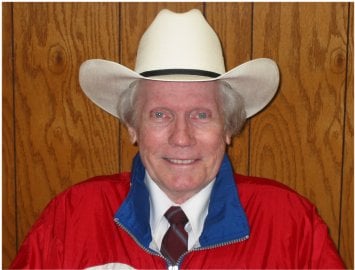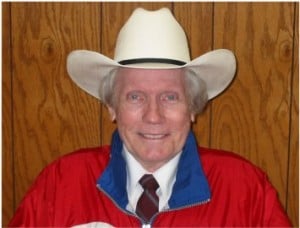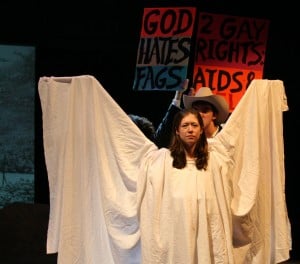[Editor’s note: News broke just a few hours after this piece was posted that Fred Phelps, Sr. died a little before midnight on March 19. May he rest in peace.]
Many people would like to see Fred Phelps, Sr. dead.
More, they’d like him to suffer while he dies. He, along with Westboro Baptist Church that he founded, has caused real hurt and pain to many, many people – to LGBT people, to their families, to Catholics and Jews and people of color, to the families of soldiers who’ve died in war. But I take no joy in the fact that he’s dying. He’s tried to crucify LGBT people and those who love them, yet I wish him no pain, no suffering. I take no comfort in angry sentiments expressed at the news of his possible death.
***
I have had four encounters with the Westboro Baptist Church. I’ve witnessed firsthand the violence of their rhetoric, the hate they promote and the distortions of the Word of God that I’ve come to love.
The first was in the summer of 1994. I was a college student, visiting New York City for the first time on my way to a internship in Washington, DC. I was there in the midst of a major event commemorating the 25th anniversary of the Stonewall Riots, widely considered the touchstone for the modern LGBT rights movement in the United States.
In front of St. Patrick’s Cathedral, a place that for many epitomized exclusion and marginalization by mainstream religion, I watched as men and women chanted angry slogans decrying what they perceived as sinful indifference in the face of a murderous plague that was devastating the gay population not only New York but the entire nation. On the other side of 5th Avenue, though, was another, smaller group. Police barricades kept the marchers and these counter-protesters separated. The signs they carried read: “God Hates Fags,” “Thank God for AIDS,” all in bright, neon colors.
I was shocked. I was disturbed. But at the time, I couldn’t take them seriously. To me, they were just some unheard of fringe group, kept to the margins where they belonged. I couldn’t have imagined I’d see them again.
The second encounter was just a few years later. I was living in Chicago, where the pastor of a Methodist church in my neighborhood had decided to conduct civil union ceremonies – long before legalized same-sex marriage was a reality – and news of his action spread across the country, attracting the attention of what I now learned was a small group called Westboro Baptist Church from Topeka, Kansas, led by one Fred Phelps, Sr.
***
Fred Phelps, Sr. became the pastor of Westboro Baptist Church in 1955, and quickly took control of the congregation. Today, almost all of the congregants are members of his own family. It’s likely that Phelps’s fire and brimstone style and his targeted animosity drove everyone else away. By the 1990s, he became focused on one thing: his absolute hatred for LGBT people born out of his conviction that God’s vengeance is being wrought upon the United States because of its “tolerance” of the LGBT community.
Westboro Baptist Church (WBC) has a disturbingly simple explanation for nearly all the world’s problems. Why are there wars? It’s God’s punishment for the fags. Natural Disasters? God’s punishment. AIDS? God’s punishment. Dead soldiers? God’s punishment.1
It’s never been really clear why Phelps adopted this extreme position. His son Mark claims his father was violently abusive and was subsequently exiled from the church and his family:
“My father,” says the 39 year-old, now a parent himself, “is addicted to hate. Why? I can’t say. But I know he has to let it out. As rage. In doing so, he has violated the sacred trust of a parent and a pastor. I’m not trying to hurt my father. And I’m not trying to save him. I’m going to tell what happened because I’ve decided it’s the only way I can overcome my past: to drag it into the light and break its chains.”
WBC rose to national prominence after Matthew Shepard was viciously murdered in Laramie, Wyoming, in 1998 – the same year they showed up in my Chicago neighborhood – when they protested Shepard’s funeral. Later, they also protested at the trial of the two accused of Shepard’s murder.
***
When WBC showed up in my Chicago neighborhood, they weren’t met with the angry yelling and exchange of invectives that I saw in New York years before. This time, there was a quiet resistance. Several people showed up to their protest side across the street from the Methodist church carrying large, white sheets, and formed a curtain around the protest group. We knew they were there thanks to the faded neon colors that bled through the sheets. We could still hear their violent shouts. But as long as the curtains were allowed to stay, we didn’t have to read the signs. Something similar happened at the trial of Matthew Shepard’s murderers. A group of young people from Laramie showed up at the courthouse, and they used white sheets too, only this time, they formed them into angels’ wings, a tactic that has been repeated at subsequent WBC actions.
After 9/11, WBC really picked up notoriety when they started protesting at the funerals of fallen soldiers – signs now read “Pray for More Dead Soldiers” and “Thank God for IEDs.” It was one thing for them to protest against LGBT issues – many Americans may have agreed with their cause, if not their tactics – but their protests at the funerals of dead soldiers united pretty much everyone against WBC.2 Similar to the angel actions, a peaceful response was organized to protect the dignity of military funerals by a group called the Patriot Guard.
***
My third encounter with WBC was just a few years ago, after I had entered the Jesuits, and once again it was in front of a cathedral. This time, I was attending mass at Seattle’s St. James Cathedral on the feast of Corpus Christi, which that year happened to fall on Seattle’s Pride Weekend. At the end of mass the cathedral assembly began its procession around the cathedral, and when we reached the corner in front of the cathedral steps, there they were. New signs joined the collection since my first WBC encounter more than 10 years prior, “Fag Church” and “Priests Rape Boys” among them.
This time, too, there were other protesters. A group of LGBT activists had gathered on another nearby corner. But this was different – they weren’t protesting the cathedral, they were there to protest WBC. Maybe the weren’t exactly for us, but they were definitely against WBC, and St. James is known as a place that embraces LGBT Catholics. And in the midst of all this, the cathedral assembly just did what we could – witnessing by our liturgy as we processed bearing the blessed sacrament, in the traditional way with incense and canopy and lanterns.
***
I wonder, how do you deal with a group that shows up all over the place and who causes so much unified anger and resistance? They’re practically a caricature of themselves, and they’d be laughable if I didn’t know the real hate and harm they cause. As such, their actions are infuriating. They provoke emotions the likes of which few of us experience – the level of rage against them that they have against LGBT people. And if you express that rage, however justified, they eat it up – just a sign that they’re doing the Lord’s work. They won’t listen to reason; they are convinced of their mission and God’s approbation. The media believes it must report on the news, but hosting them on talk shows seems to give credence to a truly objectionable organization. Cities have tried to pass laws restricting their activities, and one family even sued WBC for emotional distress in a case that was overturned by the Supreme Court on free speech grounds.3 I’d like to just ignore them, but in the digital media age, that’s become just about impossible. They’ve taken over the web; godhatesfags.com is just one of their domain names, and they have as many Twitter accounts as family members and objects of hate.
Which brings me to my fourth and most recent encounter with WBC:
Sometimes, it’s these little moments that matter. cc: @HuffPostRelig pic.twitter.com/tvHc19uGMO
— Jason Welle, SJ (@malawijay) February 4, 2014
***
And now the leader of this hate group, and founder of a family that has intentionally caused pain to countless people in this country – a family that has said they want LGBT people dead – may lay dying, and perhaps even cast out from the very congregation he founded to promote his vitriol. There are those who are happy at his pain, I suppose. You can see some of those responses here. I can’t blame them; that seems an all too human response to someone who’s lived a life like Fred Phelps has. Yet, I think something more is called for here. We can rage and rejoice over a man’s deathbed, but I feel that I need to rise above his base distortions, and more than, to rise through the pain he’s caused, and show the love he denied not just to strangers, but to members of his own family.
That’s not easy to do. But I’ve professed a faith that says that there’s a way through suffering, a way that reveals redemption. It’s a way that doesn’t remove the afflictions we suffer in life, but proves that life overcomes them. It’s the hope that we live for in Lent, when we’re remembering our wrongs, and reforming our spirits, and preparing for that new life that we realize every Easter, and every Sunday. It’s the hope that says, “Injustice may lead to the cross, but the cross leads to resurrection.” That’s the faith I want to realize right now.
I appreciate what a friend said, that when Jesus told us to love our enemies he didn’t just mean the friends who annoy us – he meant the people who want us dead. He’s right. And a lot of other people are trying to take this difficult path too, and I’m glad I’m not alone. Sometimes, it takes a community of witnesses to show faith, hope, and love.
So, I pray that in his death, those WBC has hurt will find some peace. I pray that the WBC family might come out of their confusion and find a conversion towards the true gospel.
I pray for peace for Fred Phelps. I pray that he knows not punishment, but mercy. I pray that he knows a mercy so profound and limitless that it startles him out of his darkness. I pray that the people he’s victimized know a love so sweet that it cleanses away any bitterness.4 I pray that he is led to know light and love, and that he gaze upon the face of God encompassed in divine, loving truth.
******
Fred Phelps Sr. image courtesy Wikimedia user Nicke L.; it can be found here.
Children of Westboro Baptist Church courtesy Flickr user Mel Green; it can be found here.
Matthew Shepard image courtesy GLAAD; it can be found here.
Angel Action image courtesy Wikipedia user MICDS Photographer; it can be found here.
- The BBC has a one hour documentary called The Most Hated Family in America that gives a good look into the life of WBC. ↩
- Even the KKK has denounced WBC’s actions. When the KKK thinks you’ve gone too far… ↩
- Several WBC members – children and grandchildren of Phelps – have earned law degrees, and part of their income comes from the lawsuits they’ve won. ↩
- I added this in after the original publication; I felt I needed to acknowledge the pain of his victims in a prayerful way. ↩






